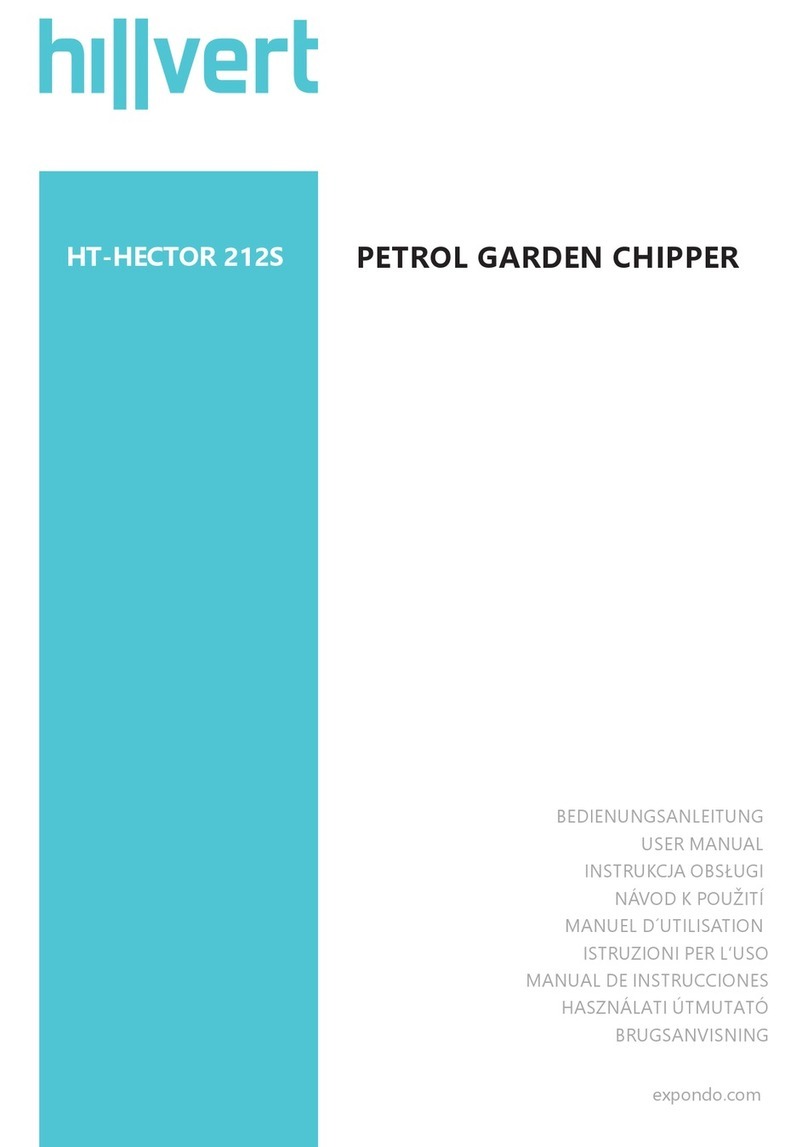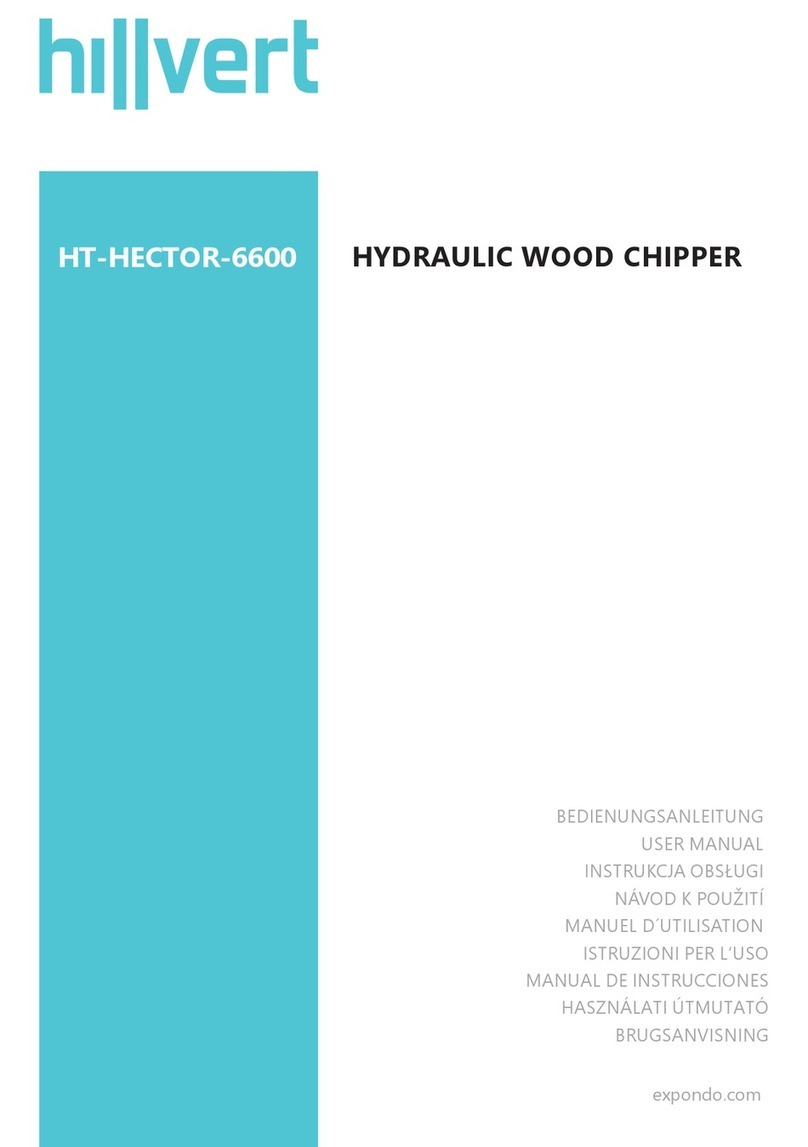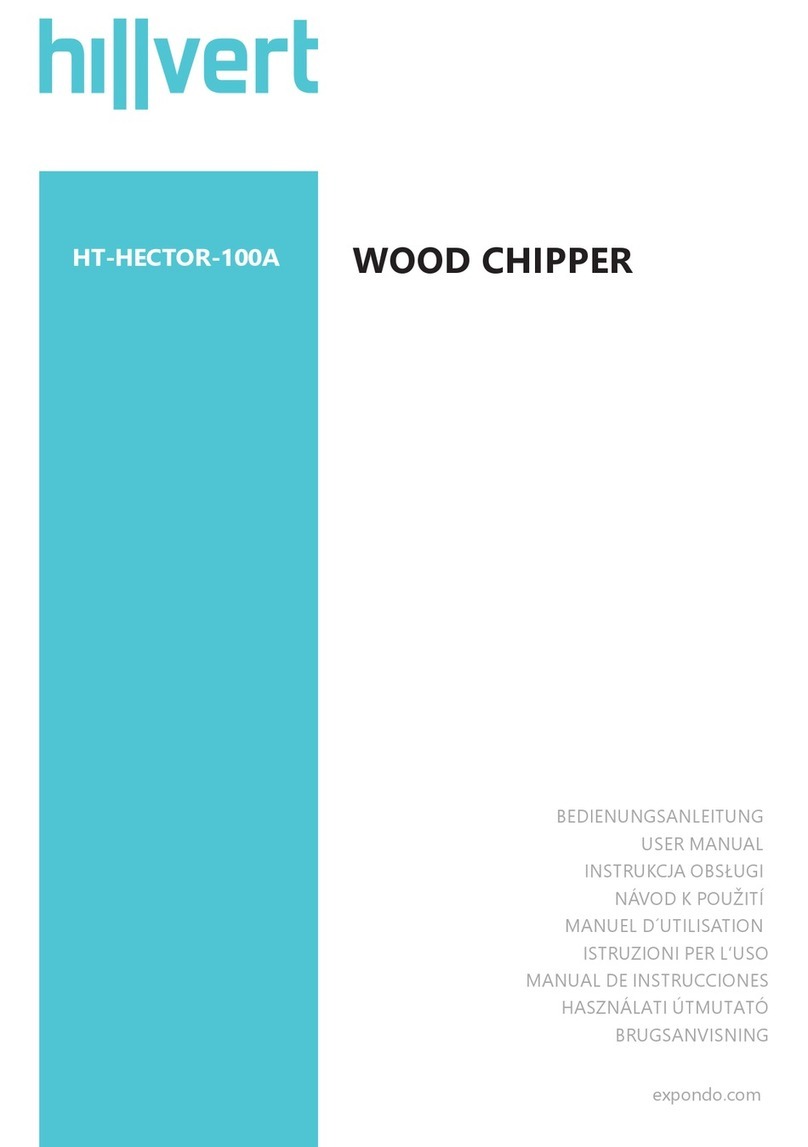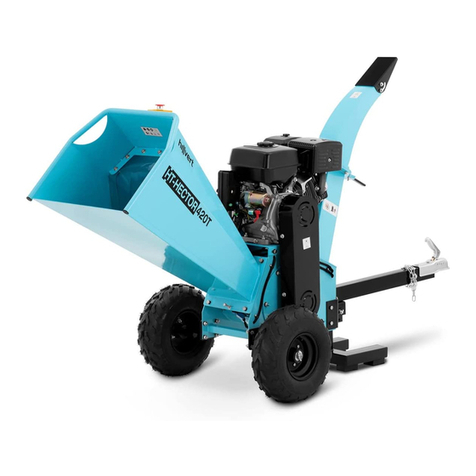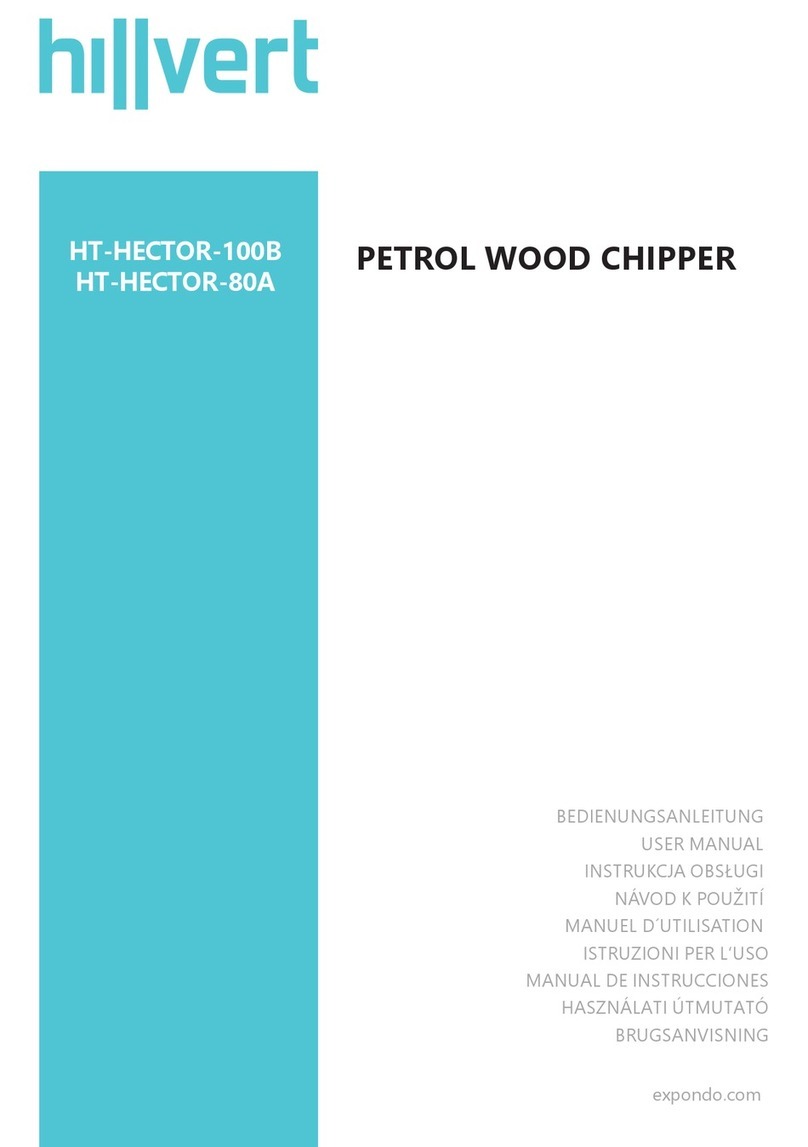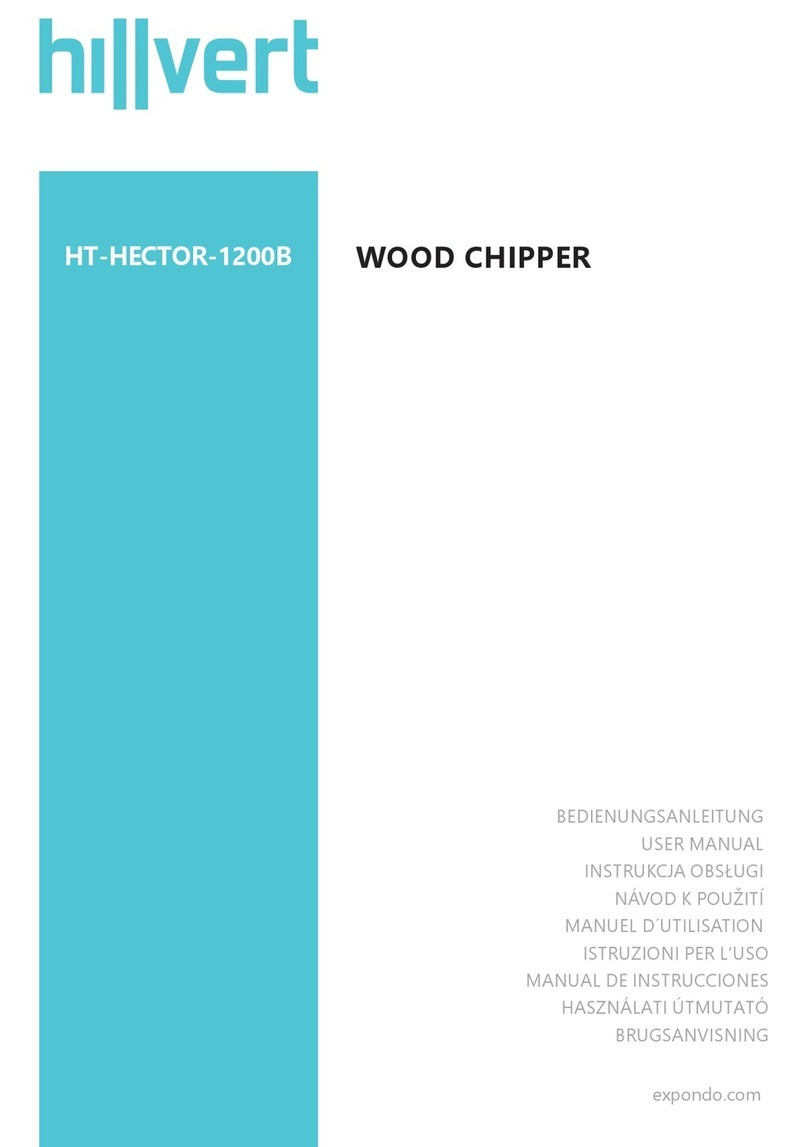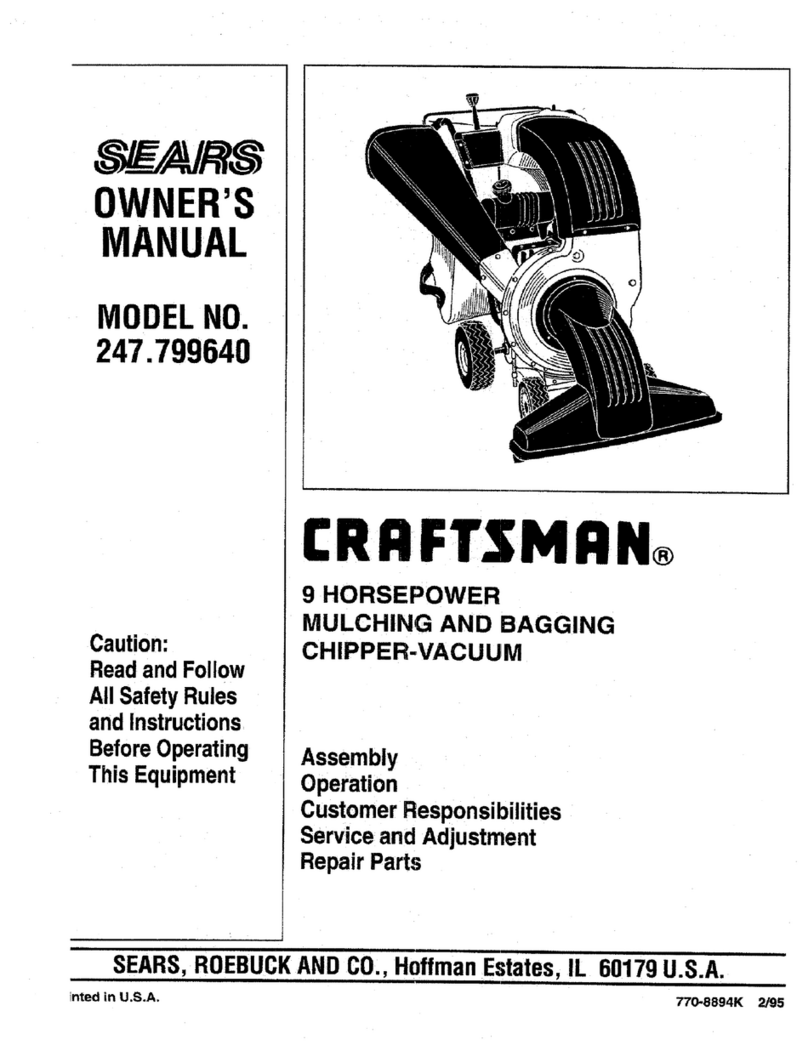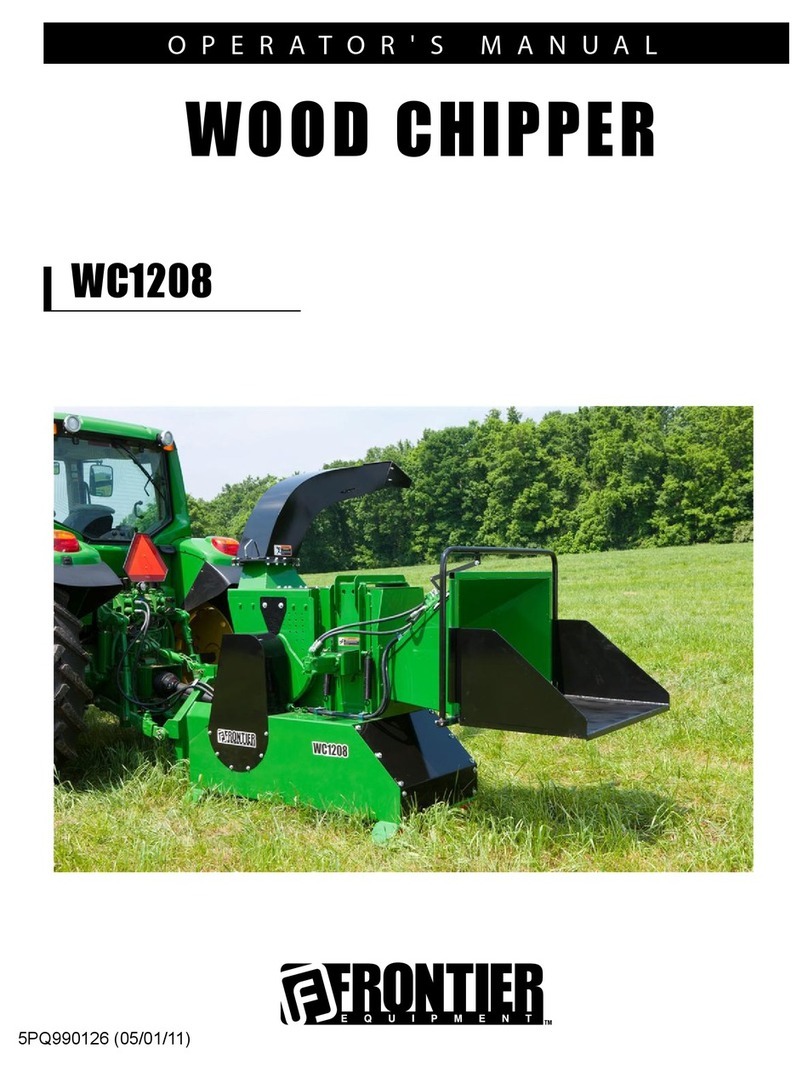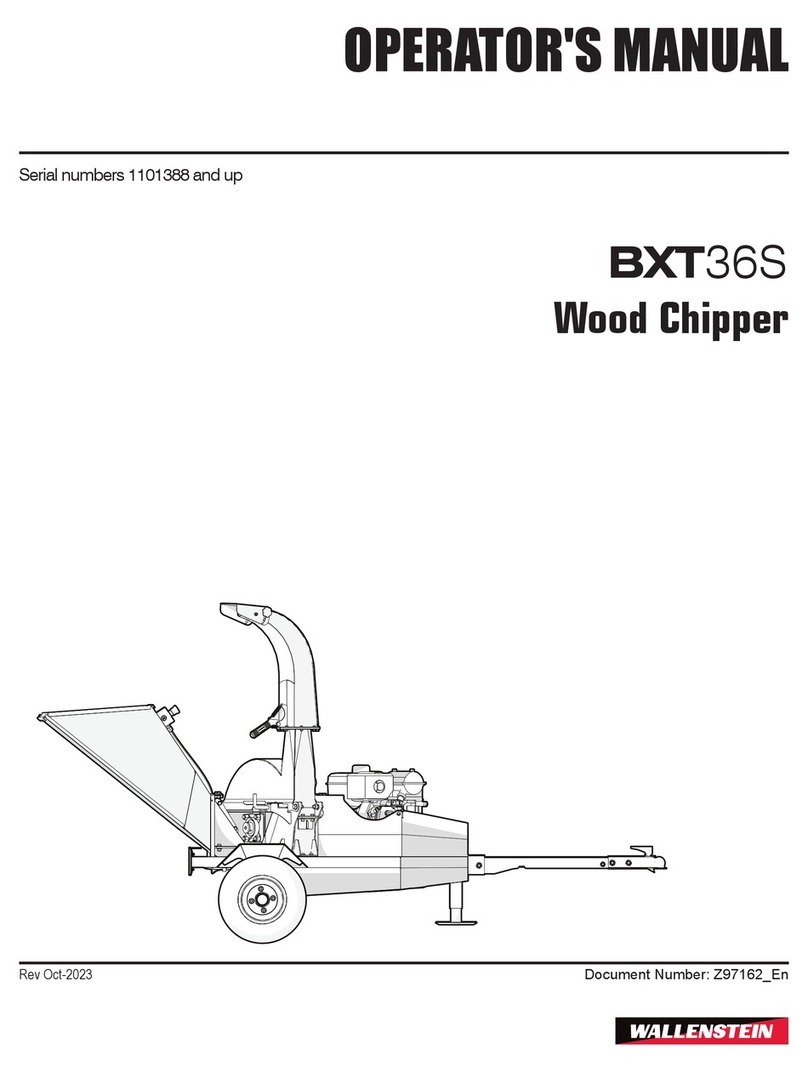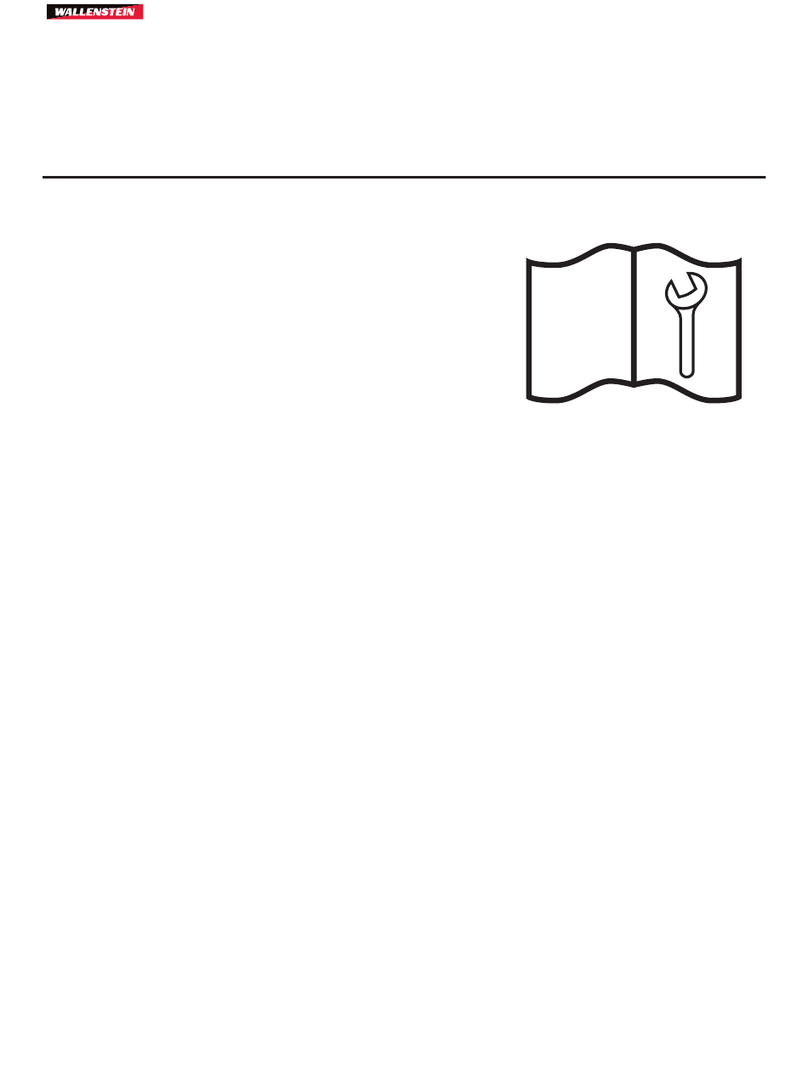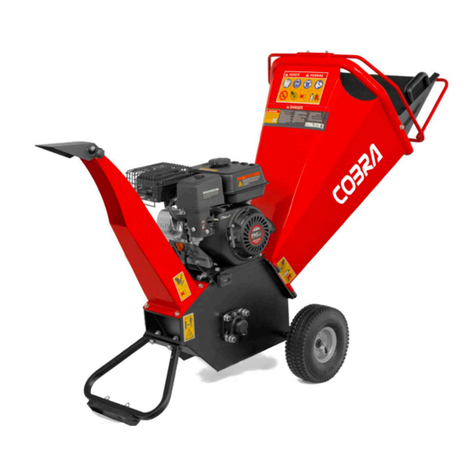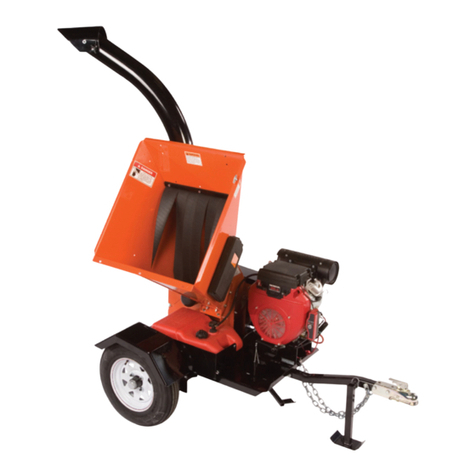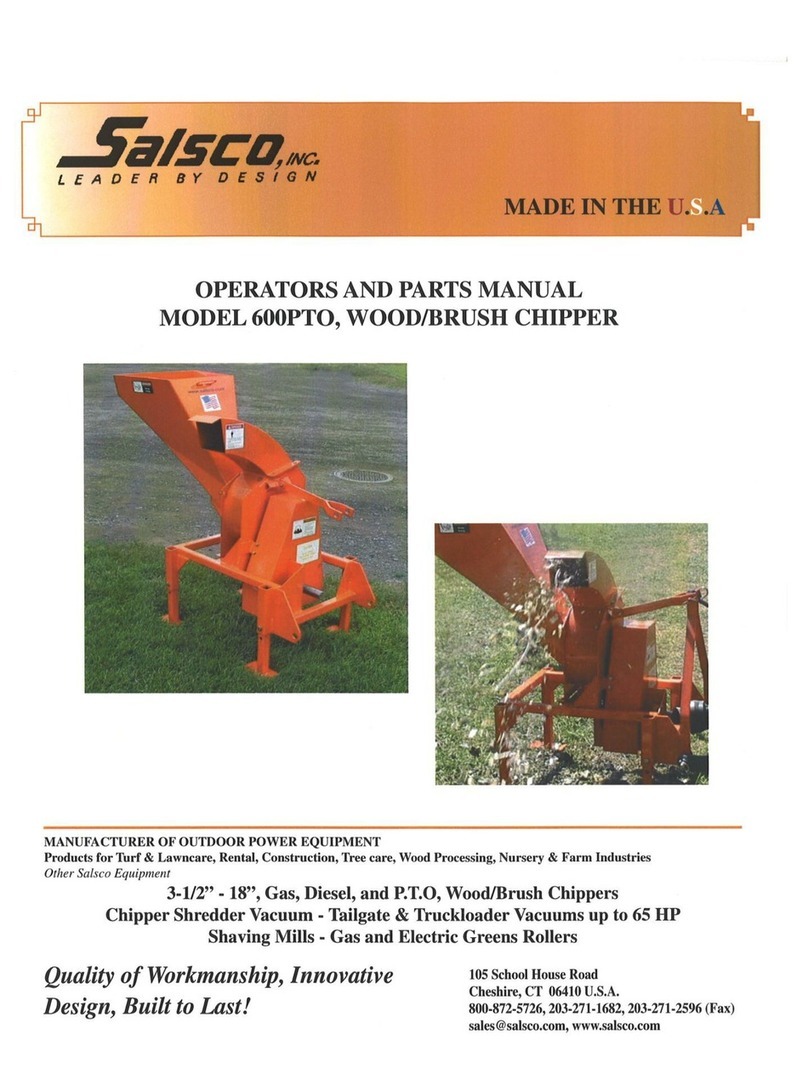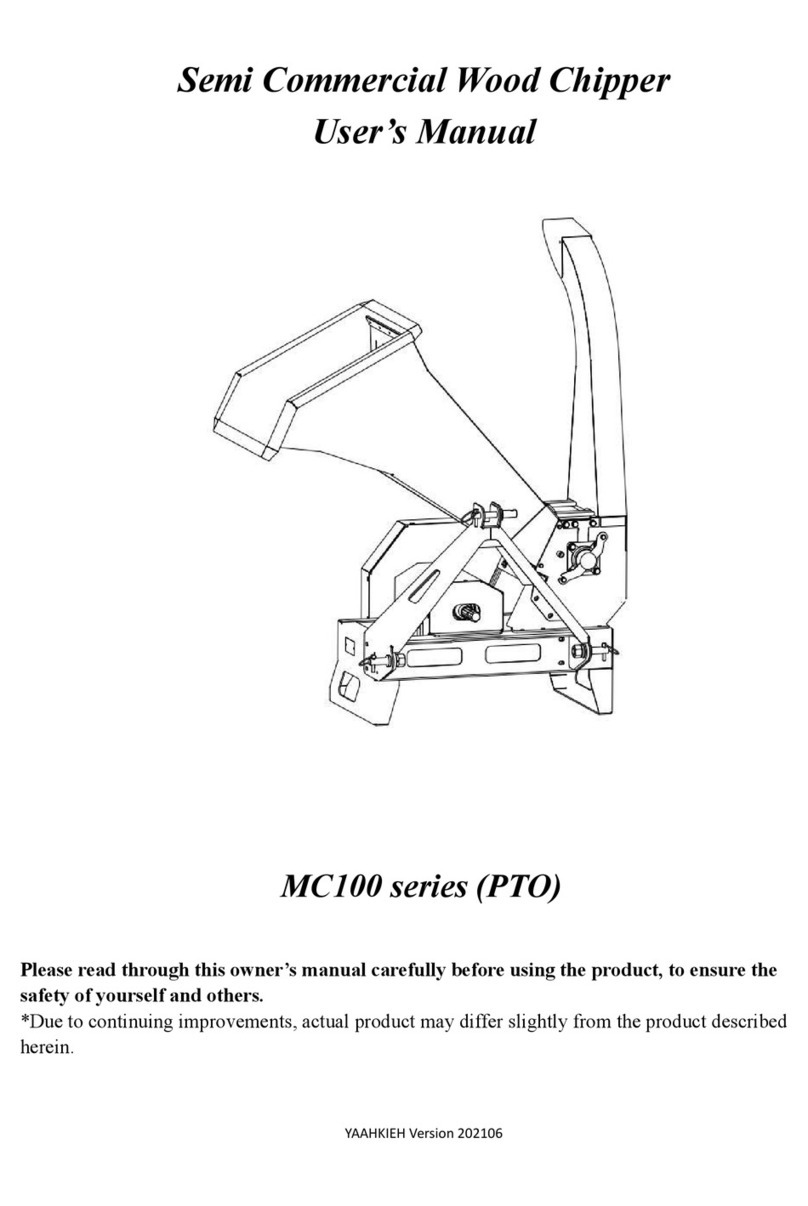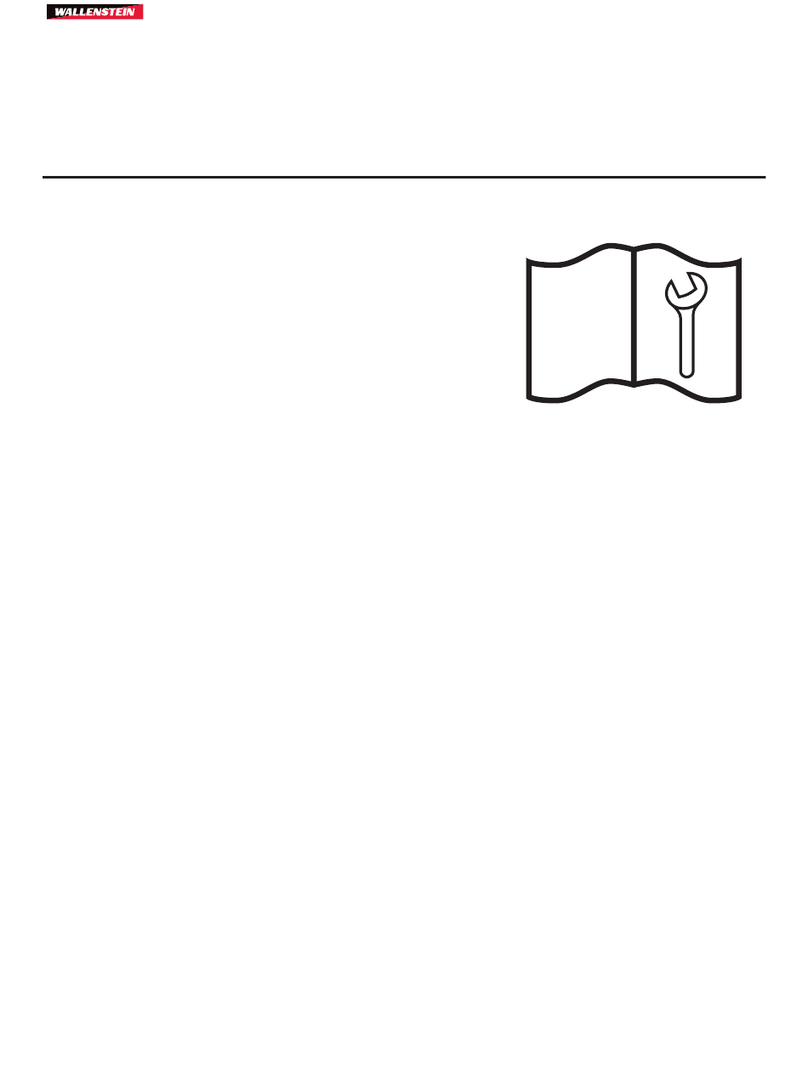
18.12.2018 18.12.2018
4 5
DEDE
f) Reparatur und Wartung von Geräten dürfen nur
von qualiziertem Fachpersonal und mit Original-
Ersatzteilen durchgeführt werden. Dadurch wird die
Sicherheit bei der Nutzung gewährleistet.
g) Um die vorgesehene Betriebsintegrität des Gerätes
zu gewährleisten, dürfen die werksmäßig montierten
Abdeckungen oder Schrauben nicht entfernt werden.
h) Beim Transport und beim Verlegen des Gerätes
vom Aufbewahrungsort zum Einsatzort sind
die Sicherheits – und Hygienevorschriften für
die manuelle Handhabung für das Land zu
berücksichtigen, in dem das Gerät verwendet wird.
i) Vermeiden Sie Situationen, in denen das Gerät bei
laufendem Betrieb unter schwerer Last stoppt. Dies
kann zu einer Überhitzung der Antriebskomponenten
und damit zu einer Beschädigung des Gerätes
führen.
j) Berühren Sie keine beweglichen Teile oder
Zubehörteile, es sei denn, das Gerät wurde vom Netz
getrennt.
k) Kippen oder transportieren Sie das Gerät nicht
während des Betriebs.
l) Lassen Sie das Gerät während des Betriebs nicht
unbeaufsichtigt. Schalten Sie die Maschine aus und
trennen Sie das Zündkerzenkabel, wenn Sie den
Einsatzbereich verlassen.
m) Das Gerät regelmäßig reinigen, damit sich kein
Schmutz auf Dauer festsetzen kann.
n) Das Gerät ist kein Spielzeug. Reinigung und Wartung
dürfen nicht von Kindern ausgeführt werden, wenn
diese nicht unter der Aufsicht von Erwachsenen
stehen.
o) Die Elemente der Entleerungsrustche oder andere
Teile nicht bei laufendem Motor einbauen, entfernen,
regulieren oder warten.
p) Halten Sie bei laufendem Motor alle Körperteile und
schweren Gegenstände vom Einfülltrichter (dem
Haupttrichter und dem zusätzlichen Trichter für HT-
HECTOR 212) sowie der Auswurfrutsche fern.
q) Stecken Sie keine Gliedmaßen bei laufender
Maschine in den Einfülltrichter und den Spanauswurf.
Gliedmaßen können eingezogen und/oder
abgetrennt werden.
r) Legen Sie kein Metall, Steine, Flaschen, Dosen und
andere Gegenstände, außer Panzen, in das Gerät.
s) Rotierende Schneidklingen in diesen Önungen
können bei Berührung schwere Verletzungen
verursachen.
t) Bleiben Sie während des Betriebs achtsam. Die
Maschine kann verarbeitetes Material aus dem
Einfülltrichter oder der Auswurfrutsche auswerfen.
u) Der Motor wird während des Betriebs sehr heiß.
Berühren Sie nicht den heißen Motor, da dies zu
Verbrennungen führen kann.
v) Halten Sie Blätter, Gras und andere brennbare
Materialien vom heißen Motor und den
Schalldämpfern fern, um die Gefahr eines Brands zu
vermeiden.
w) Arbeiten Sie nicht auf Gehwegen, Kies oder anderen
harten Oberächen, da Gegenstände abprallen und
Verletzungen verursachen können.
x) Einige Baumarten können allergische Reaktionen
auslösen. Der während der Verarbeitung austretende
Staub kann schädlich sein; treen Sie geeignete
Schutzmaßnahmen.
y) Entfernen Sie die Verriegelungen des Geräts nicht
mit den Händen.
z) Nehmen Sie das Gerät nicht auf unebenem Gelände
in Betrieb oder wenn das Gerät instabil ist.
aa) Achtung! Das verarbeitete Material kann vom
Einfülltrichter abprallen oder aus der Auswurfrutsche
ausgeworfen werden.
bb) Wenn der Motor aufgrund eines Staus zum Stillstand
gekommen ist, stellen Sie den Gashebel auf „Stopp“
oder stellen Sie den Schalter vor der Reinigung auf
„0“ (sofern ein solcher Schalter installiert ist).
cc) Wenn der Häcksler verstopft ist oder klemmt,
schalten Sie den Motor sofort aus und warten Sie,
bis alle beweglichen Teile vollständig zum Stillstand
gekommen sind, bevor Sie die Wartung durchführen.
dd) Legen Sie keine größeren Zweige als in den
technischen Daten angegeben in das Gerät ein.
ee) Stellen Sie sicher, dass der Einfülltrichter (der
Haupttrichter sowie der zusätzliche Trichter für
das Modell HT-HECTOR 212) leer ist, bevor Sie die
Maschine starten.
) Füllen Sie vor der Inbetriebnahme ausreichend Öl in
das Gerät ein. Bei zu niedrigem Ölstand startet der
Motor nicht oder stellt sich ab.
gg) Das Austreten von Serviceölen aus dem Gerät sollte
den entsprechenden Stellen gemeldet werden bzw.
halten Sie sich an die hierfür geltenden gesetzlichen
Bestimmungen.
hh) Gefahr! Gesundheitsgefährdung und
Explosionsgefahr des Verbrennungsmotors
ii) In den Motorabgasen bendet sich giftiges
Kohlenmonoxid. Ein Aufenthalt in einer
Kohlenmonoxid-Umgebung kann zu
Bewusstlosigkeit und sogar zum Tod führen. Lassen
Sie den Motor nicht in einem geschlossenen Raum
laufen.
jj) Schützen Sie den Motor vor Hitze, Funken und
Flammen. Rauchen Sie nicht in der Nähe des
Häckslers!
kk) Benzin ist leicht brennbar und explosiv. Vor dem
Auftanken sollte der Motor abgestellt werden und
abkühlen.
ll) Achtung! Gefahr von Motorschäden durch falschen
Kraftsto.
mm) Der Geräteakkumulator steht unter Strom. Berühren
Sie nicht die (Akkumulator-)Anschlüsse. Das Trennen
der Anschlüsse von dem Akkumulator sollte in der
richtigen Reihenfolge erfolgen.
b) Die Maschine darf nur durch entsprechend
geschulte, zur Bedienung geeignete und physisch
gesunde Personen bedient werden, die die
vorliegende Anleitung gelesen haben und die
Arbeitsschutzanforderungen kennen.
c) Die Maschine ist nicht dazu bestimmt, durch
Personen (darunter Kinder) mit eingeschränkten
physischen, sensorischen und geistigen Fähigkeiten
bzw. durch Personen ohne entsprechende Erfahrung
und/oder entsprechendes Wissen bedient zu
werden, es sei denn es gibt eine für ihre Aufsicht
und Sicherheit zuständige Person bzw. sie haben von
dieser Person entsprechende Hinweise in Bezug auf
die Bedienung der Maschine erhalten.
d) Seien Sie aufmerksam und verwenden Sie Ihren
gesunden Menschenverstand beim Betreiben
des Gerätes. Ein Moment der Unaufmerksamkeit
während der Arbeit kann zu schweren Verletzungen
führen.
e) Benutzen Sie persönliche Schutzausrüstung, die für
den Betrieb des Gerätes entsprechend den in Punkt 1
der Symbolerläuterungen vorgegebenen Maßgaben
erforderlich ist. Die Verwendung geeigneter
und zertizierter persönlicher Schutzausrüstung
verringert das Verletzungsrisiko.
f) Überschätzen Sie Ihre Fähigkeiten nicht. Halten Sie
Balance und Gleichgewicht während der Arbeit. Dies
gibt Ihnen eine bessere Kontrolle über das Gerät im
Falle unerwarteter Situationen.
g) Tragen Sie keine lose Kleidung oder Schmuck.
Halten Sie Haare, Kleidung und Handschuhe von
beweglichen Teilen fern. Lose Kleidung, Schmuck
oder lange Haare können durch bewegliche Teile
ergrien werden.
h) Entfernen Sie alle Einstellwerkzeuge oder Schlüssel,
bevor Sie das Gerät einschalten. Gegenstände, die
in rotierenden Teilen verbleiben, können zu Schäden
und Verletzungen führen.
i) Das Gerät ist kein Spielzeug. Kinder sollten unter
Aufsicht stehen, damit sie nicht mit dem Gerät
spielen.
2.3. SICHERE ANWENDUNG DES GERÄTS
a) Überhitzen Sie das Gerät nicht. Verwenden Sie
geeignete Werkzeuge für die entsprechende
Anwendung. Richtig ausgewählte Geräte und der
sorgsame Umgang mit ihnen führt zu besseren
Arbeitsergebnissen.
b) Benutzen Sie das Gerät nicht, wenn der EIN-/AUS-
Schalter nicht ordnungsgemäß funktioniert. Geräte,
die per Schalter nicht gesteuert werden können sind
gefährlich und müssen repariert werden.
c) Nicht verwendete Werkzeuge sind außerhalb
der Reichweite von Kindern sowie von Personen
aufzubewahren, welche weder das Gerät selbst, noch
die entsprechende Anleitung kennen. In den Händen
unerfahrener Personen können derlei Geräte eine
Gefahr darstellen.
d) Halten Sie das Gerät im einwandfreien Zustand.
Überprüfen Sie vor jeder Arbeit, ob allgemeine
Schäden vorliegen oder Schäden an beweglichen
Teilen (Bruch von Teilen und Komponenten oder
andere Bedingungen, die den sicheren Betrieb der
Maschine beeinträchtigen könnten). Im Falle eines
Schadens muss das Gerät vor Gebrauch in Reparatur
gegeben werden.
e) Halten Sie das Gerät außerhalb der Reichweite von
Kindern.
2.2. PERSÖNLICHE SICHERHEIT
a) Es ist nicht gestattet, das Gerät im Zustand der
Ermüdung, Krankheit, unter Einuss von Alkohol,
Drogen oder Medikamenten zu betreiben, wenn diese
die Fähigkeit das Gerät zu bedienen, einschränken.
Der Begri „Gerät“ oder „Produkt“ in den Warnungen und
Beschreibung des Handbuchs bezieht sich auf < Benzin
Gartenhäcksler, Benzin Holzhäcksler >. Benutzen Sie das
Gerät nicht in Räumen mit sehr hoher Luftfeuchtigkeit /
in unmittelbarer Nähe von Wasserbehältnissen! Lassen
Sie das Gerät nicht nass werden. Gefahr eines elektrischen
Schlags! Legen Sie keine Hände oder Gegenstände in das
laufende Gerät! Die Ventilationsönungen dürfen nicht
verdeckt werden!
2.1. SICHERHEIT AM ARBEITSPLATZ
a) Halten Sie Ihren Arbeitsplatz sauber und gut
beleuchtet. Unordnung oder schlechte Beleuchtung
können zu Unfällen führen. Seien Sie voraussichtig,
beobachten Sie, was getan wird und bewahren
Sie Ihren gesunden Menschenverstand bei der
Verwendung des Gerätes.
b) BenutzenSiedasGerätnichtinexplosionsgefährdeten
Bereichen, zum Beispiel in Gegenwart von
brennbaren Flüssigkeiten, Gasen oder Staub. Geräte
können unter Umständen Funken erzeugen, welche
Staub oder Dämpfe entzünden können.
c) Im Falle eines Schadens oder einer Störung sollte
das Gerät sofort ausgeschaltet und dies einer
autorisierten Person gemeldet werden.
d) Wenn Sie nicht sicher sind, ob das Gerät
ordnungsgemäß funktioniert, wenden Sie sich an
den Service des Herstellers.
e) Reparaturen dürfen nur vom Service des Herstellers
durchgeführt werden. Führen Sie keine Reparaturen
auf eigene Faust durch!
f) Zum Löschen des Gerätes bei Brand oder Feuer, nur
Pulver-Feuerlöscher oder Kohlendioxidlöscher (CO2)
verwenden.
g) Kinder und Unbefugte dürfen am Arbeitsplatz nicht
anwesend sein. (Unachtsamkeit kann zum Verlust der
Kontrolle über das Gerät führen).
h) Während des Betriebs produziert das Gerät Staub
und Schmutz. Unbeteiligte Personen müssen vor
ihren schädlichen Auswirkungen geschützt werden.
i) Im Falle einer Lebens – oder Gesundheitsgefahr,
eines Unfalls oder eines Ausfalls, stoppen Sie das
Gerät durch Drücken der NOT-STOPP-TASTE!
j) Überprüfen Sie regelmäßig den Zustand der
Sicherheitsinformationsaufkleber. Falls die Aufkleber
unleserlich sind, sollten sie ausgetauscht werden.
k) Bewahren Sie die Gebrauchsanleitung für den
weiteren Gebrauch auf. Sollte dieses Gerät
an Dritte weitergegeben werden, muss die
Gebrauchsanleitung mit ausgehändigt werden.
l) Halten Sie Kinder und andere Personen von der
Maschine fern.
m) Stellen Sie sicher, dass der Arbeitsplatz frei ist.
2. NUTZUNGSSICHERHEIT
ACHTUNG!Lesen Sie alle Sicherheitshinweise und
alle Anweisungen durch. Die Nichtbeachtung der
Warnungen und Anweisungen kann zu elektrischen
Schlägen, Feuer und / oder schweren Verletzungen
bis hin zum Tod führen.
HINWEIS!Kinder und Unbeteiligte müssen bei der
Arbeit mit diesem Gerät gesichert werden.
3. NUTZUNGSBEDINGUNGEN
Das Gerät ist für das Häckseln von Ästen, Büschen, Unkraut,
Trieben und langen Gräsern mit einem Durchmesser
bestimmt, der den in der Tabelle mit den technischen Daten
angegebenen Wert nicht überschreitet. Verwenden Sie das
Gerät nicht zum Häckseln von Bauschutt, Kunststoen,
Papierprodukten, Seilen oder Schnüren oder anderen
Materialien, die Metall enthalten können.
Achtung: Entfernen Sie alle Nägel, Seile, Schnüre oder
Steine, die an Panzen (z.B. an den Wurzeln) haften können,
bevor Sie das Material in das Gerät einführen.
Für alle Schäden bei nicht sachgemäßer Verwendung
haftet allein der Betreiber.
3.1. GERÄTEBESCHREIBUNG
ACHTUNG!Obwohl das Gerät mit dem Gedanken an
die Sicherheit entworfen wurde, besitzt es bestimmte
Schutzmechanismen. Trotz der Verwendung
zusätzlicher Sicherheitselemente besteht bei der
Bedienung immer noch ein Verletzungsrisiko. Es wird
empfohlen, bei der Nutzung Vorsicht und Vernunft
walten zu lassen.
ACHTUNG! Die Zeichnung von diesem
Produkt bendet sich auf der letzte Seite der
Bedienungsanleitung S.56.

